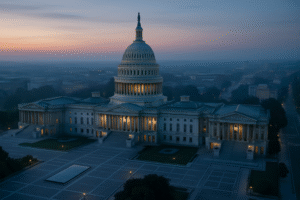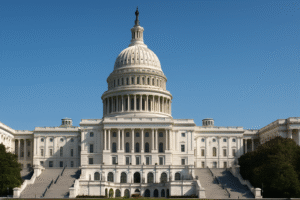Duration & Credit Pulse
Executive Summary
Bottom Line: Credit spreads compressed to 15-year lows with investment grade at 73 basis points and high yield at 278 basis points, defying day 19 of the federal government shutdown and escalating trade tensions. Fed Chair Powell's October 14 speech signaling imminent quantitative tightening cessation and continued rate cuts overwhelmed fundamental concerns, driving Treasury yields modestly lower (10-year down 2 bps to 4.01%) while repo market stress episodes highlighted underlying liquidity fragility that validates the Fed's policy pivot.
Duration Dashboard
| Maturity | October 12, 2025 | October 19, 2025 | Weekly Δ | 5-Year Percentile |
|---|---|---|---|---|
| 2‑Year | 3.50% | 3.46% | -4 bp | 38th %ile (middle range) |
| 5‑Year | 3.63% | 3.59% | -3 bp | 43rd %ile (middle range) |
| 10‑Year | 4.03% | 4.01% | -2 bp | 60th %ile (middle range) |
| 30‑Year | 4.62% | 4.61% | -1 bp | 80th %ile (elevated) |
Liquidity Stress Drives Front-End Rally
Curve Analysis: The Treasury curve steepened modestly as Fed Chair Powell's dovish pivot drove outsized front-end rallies. The 2-year yield fell 4 basis points to 3.46% on solidifying expectations for continued rate cuts, while the 30-year declined just 1 basis point to 4.61%, maintaining its elevated 80th percentile positioning. The 2s30s spread widened from 112 to 115 basis points, reflecting market conviction that the Fed will ease aggressively despite sticky long-term inflation concerns. Repo market stress episodes with SOFR spiking to 4.41% intraweek validated Powell's rationale for ending quantitative tightening.
Treasury markets navigated an extraordinary confluence of policy signals during the week, with Fed Chair Powell's October 14 speech overwhelming the chaos of the government shutdown entering its 19th day. The 10-year yield's modest 2 basis point decline to 4.01% masked significant intraday volatility, as markets whipsawed between safe-haven flows from trade tensions and concerns about fiscal dysfunction. Powell's acknowledgment that "liquidity conditions are gradually tightening" and quantitative tightening may end "in coming months" provided the week's dominant narrative, cementing expectations for a 25 basis point rate cut at the October 28-29 FOMC meeting with 98% probability priced in fed funds futures.
Credit Spreads at Historic Lows October 2025
| Metric | October 12, 2025 | October 19, 2025 | Weekly Δ | 5-Year Percentile |
|---|---|---|---|---|
| IG OAS | 78 bp | 73 bp | -5 bp | 18th %ile (tight) |
| HY OAS | 296 bp | 278 bp | -18 bp | 23rd %ile (tight) |
| VIX Index | 21.66 | 20.78 | -0.88 | 65th %ile (normal) |
Credit markets delivered a remarkable compression to historic tights, with investment grade spreads at 73 basis points reaching the lowest levels since 2010 and positioning at just the 18th percentile of the 5-year range. High yield's 18 basis point tightening to 278 basis points brought spreads to the 23rd percentile, approaching the all-time low of 240 basis points from 2007. This aggressive risk-taking occurred despite the federal government shutdown, Trump's 100% China tariff threat, and repo market stress episodes, highlighting how technical factors and the search for yield have completely overwhelmed fundamental analysis. The disconnect between compressed spreads and elevated systemic risks suggests dangerous complacency.
US Macroeconomic Assessment – Data Void Meets Policy Chaos
The week of October 12-19 marked an extraordinary period where the federal government shutdown's data blackout collided with critical policy crossroads, leaving markets to navigate without their usual economic compass. The shutdown, extending through its 19th day with no resolution in sight, suspended all Bureau of Labor Statistics releases including September CPI, retail sales, and weekly jobless claims. This information vacuum occurred precisely when markets needed clarity on inflation trajectory, consumer resilience, and labor market dynamics to assess the Fed's policy path. The shutdown's economic toll mounted with the Treasury Department warning of $15 billion daily GDP impact and 750,000 federal workers furloughed.
Fed navigates blind as QT end looms: Chair Powell's October 14 speech to the National Association for Business Economics proved the week's pivotal event, signaling imminent quantitative tightening cessation despite lacking current economic data. Powell acknowledged "some important government data have been delayed" but emphasized the Fed reviews "a wide variety of public- and private-sector data that have remained available." His observation that "liquidity conditions are gradually tightening" with repo rates firming proved prescient, as SOFR spiked to 4.41% on October 17, forcing banks to tap the Standing Repo Facility. The Fed's balance sheet reduction from $3.3 trillion to $3.0 trillion in reserves approaches practical limits, with Powell suggesting QT may end "in coming months."
Trade war escalation compounds uncertainty: President Trump's October 10 threat of 100% tariffs on all Chinese imports "over and above" existing duties marked a dramatic escalation in response to China's October 9 announcement of rare-earth export controls. Beijing's restrictions on 12 of 17 rare-earth metals—materials where China controls the vast majority of global processing capacity—target critical inputs for electric vehicles, smartphones, semiconductors, and defense systems. The October 14 implementation of multiple tariff tranches added immediate pressure: Section 301 maritime actions targeting Chinese-built vessels, 25% furniture duties rising to 50% in January, and 10% softwood lumber tariffs set to triple by year-end. This tit-for-tat escalation, with Trump's November 1 deadline for 100% tariffs looming, creates stagflationary impulses markets struggle to price without inflation data. The rare-earth restrictions particularly threaten technology and defense sectors, potentially disrupting supply chains more severely than tariffs alone.
Private data hints at resilience amid chaos: In the absence of official statistics, private sector proxies provided fragmentary insights. The Chicago Fed's CARTS index suggested September retail sales excluding autos rose 0.5%, down from 0.7% in August but still positive. Ohio's state unemployment data showed initial claims of 4,527, down 666 from the prior week, hinting at continued labor market tightness. The Fed's October 15 Beige Book found economic activity "little changed on balance" with a widespread "hiring chill" as employers welcomed attrition. Manufacturing remained weak with ISM at 49.1 for the 24th consecutive contractionary month, though new orders at 48.9 showed modest stabilization.
Federal Reserve Policy Outlook
The Federal Reserve enters its October 28-29 FOMC meeting in an unprecedented position—making critical policy decisions without September inflation data, retail sales, or comprehensive employment statistics due to the government shutdown. Powell's October 14 pivot toward ending quantitative tightening reflects growing concern that the Fed's balance sheet reduction has gone too far, with repo market stress episodes validating these fears. Markets have fully embraced the dovish narrative with 98.1% probability of a 25 basis point October cut and 87% chance of another December reduction bringing fed funds to 3.50-3.75%.
The intellectual framework for simultaneous rate cuts and QT cessation rests on Powell's distinction between interest rate policy addressing economic conditions and balance sheet policy ensuring financial system plumbing. Yet this neat separation ignores how ending QT while cutting rates could reignite inflation expectations just as tariffs create supply-side price pressures. The Committee must navigate this without updated dot plots until December, leaving markets to divine intentions from Powell's press conference—potentially the most consequential since the inflation fight began. The data void may paradoxically give the Fed cover for aggressive easing, arguing uncertainty justifies insurance cuts.
Week Ahead: FOMC Decision Without Data Compass
- FOMC Meeting (October 28-29): Most important Fed meeting in years as Committee addresses QT cessation, rate cuts, and tariff implications without September economic data. Powell's press conference becomes critical for 2025 guidance. Markets price 98% probability of 25bp cut.
- November 1 China Tariff Deadline: Trump's 100% tariff threat effective date creates massive event risk. Implementation would trigger immediate credit spread widening and test the technical bid supporting markets.
- Bank of Japan Decision (October 29-30): Governor Ueda signals no urgency for rate hikes despite yen weakness, maintaining divergence from Fed trajectory and supporting carry trade dynamics.
- Data Releases (If Shutdown Ends): Q3 GDP, Core PCE, and employment data would provide first comprehensive economic readings in weeks, but release depends on shutdown resolution.
Credit Market Dynamics and Historic Spread Compression
The compression of credit spreads to 15-year tights amid mounting systemic risks represents the week's most striking paradox. Investment grade spreads at 73 basis points sit at just the 18th percentile of the 5-year range, offering minimal compensation for credit risk despite government dysfunction, trade wars, and recession probabilities rising to 33%. Technical factors proved overwhelming with September's $207 billion investment grade issuance—the fifth-largest monthly total on record—absorbed with 4x oversubscription for quality names. Foreign investors' $309 billion in purchases over 12 months provided persistent bid support, while record money market funds at $7.40 trillion represent dry powder awaiting deployment.
VIX-MOVE divergence signals regime uncertainty: The week revealed an extraordinary anomaly in cross-asset volatility with the VIX remaining elevated at 20-21 (65th percentile) following its spike earlier in October, while the MOVE index remained subdued at just 69, well below the 80 stress threshold and dramatically below the 200 level seen during the March 2023 banking crisis. This divergence—equity volatility elevated while Treasury volatility remained at just 69—historically precedes regime changes as markets struggle to price whether risks are equity-specific or systemic. The MOVE at 69 represents extreme Treasury market complacency given the shutdown, repo stress, and tariff threats. The last comparable VIX-MOVE divergence occurred in early 2007 when credit markets ignored equity warning signals. Today's divergence suggests bond investors view Powell's dovish pivot as sufficient to contain systemic risks, a potentially dangerous assumption given fiscal dysfunction and trade war escalation.
Violent sector rotation beneath calm surface: While index-level spreads compressed, dramatic dispersion emerged across sectors. Energy credits widened 25-40 basis points as WTI crude declined to $60-64 per barrel with global oil markets in surplus per IEA data. Utilities outperformed with issuance surging 18% year-over-year on data center power demand, accessing capital at historically favorable terms. Technology credits benefited from AI infrastructure spending with Oracle and major tech issuers seeing razor-thin new issue concessions. Financials experienced October 17 whipsaw volatility—initially selling off on regional bank concerns before recovering on regulatory relief expectations. Retail and consumer discretionary faced pressure from tariff implementation fears, while REITs rallied on rate cut expectations. This rotation intensity beneath compressed index spreads reveals significant positioning adjustments.
Maturity wall creates slow-motion crisis: Beneath the calm, a refinancing tsunami builds with $475 billion in high-yield bonds and leveraged loans maturing 2025-2027, followed by an unprecedented $674 billion spike in 2028—41% more than the prior three years combined. Critically, 27% of 2025 maturities are rated Caa or lower in distressed territory, with 52% of year-to-date defaults occurring via distressed exchanges that historically see 35% re-default rates within 48 months. The current environment of compressed spreads provides a narrow window for refinancing, but any spread widening could trap weaker issuers. With leveraged loan default rates already elevated at 6.9-7.5% versus 3.1-4.5% for high yield bonds, the loan market shows early stress that typically precedes broader credit deterioration. Asset managers holding $700 billion net long Treasury futures versus leveraged funds' $800 billion net shorts creates additional positioning risk when this refinancing wave hits.
Key Articles of the Week
-
Speech by Chair Powell on the Economic Outlook and Monetary PolicyFederal ReserveOctober 14, 2025Read Article
-
Beige Book: Economic Activity Little Changed, Hiring Chill SpreadsFederal ReserveOctober 15, 2025Read Article
-
Trump's 100% Tariff Threat: History of US Trade Measures Against ChinaAl JazeeraOctober 13, 2025Read Article
-
Volatility Returns: VIX Spike and Leveraged ETFs Signal Heightened CautionFinancialContentOctober 16, 2025Read Article
-
Government Shutdown Poised to Enter Third Week as Congress StalematesCBS NewsOctober 18, 2025Read Article
-
US Two-Year Yields Hover Near Lows Seen in April Tariff TurmoilBloombergOctober 15, 2025Read Article
-
Big Rates Market Trade Envisions End of Fed Balance Sheet UnwindReuters via Investing.comOctober 16, 2025Read Article
-
Q4 2025 Corporate Bond Market Outlook: Historic Spread CompressionBreckinridge Capital AdvisorsOctober 14, 2025Read Article
Frequently Asked Questions – October 2025 Fixed Income
Why are credit spreads at historic lows during a government shutdown?
Credit spreads compressed to 15-year lows despite the shutdown because technical factors overwhelmed fundamentals. Record foreign buying of $309 billion over 12 months, $7.4 trillion in money market funds seeking yield, and the Fed's dovish pivot created insatiable demand that absorbed September's massive $207 billion investment grade issuance.
How can the Fed make policy decisions without economic data?
The Fed relies on private sector proxies and its own internal models during the data blackout. Powell noted the Fed reviews "wide variety of public- and private-sector data" including bank lending surveys, credit card spending data, and regional Fed indices. The October 28-29 FOMC will emphasize risk management over data dependence.
What does ending quantitative tightening mean for bond markets?
Ending QT would halt the Fed's balance sheet reduction, keeping more liquidity in the system and potentially supporting Treasury and credit markets. Powell signaled this could happen within months after repo market stress showed reserves approaching minimum comfortable levels. This removes a source of Treasury supply pressure.
How might 100% China tariffs impact fixed income markets?
Implementation of 100% China tariffs on November 1 would create stagflationary pressure—slowing growth while increasing inflation. This could steepen the yield curve as long rates rise on inflation fears while short rates fall on recession concerns. Credit spreads would likely widen significantly on corporate margin compression fears.







